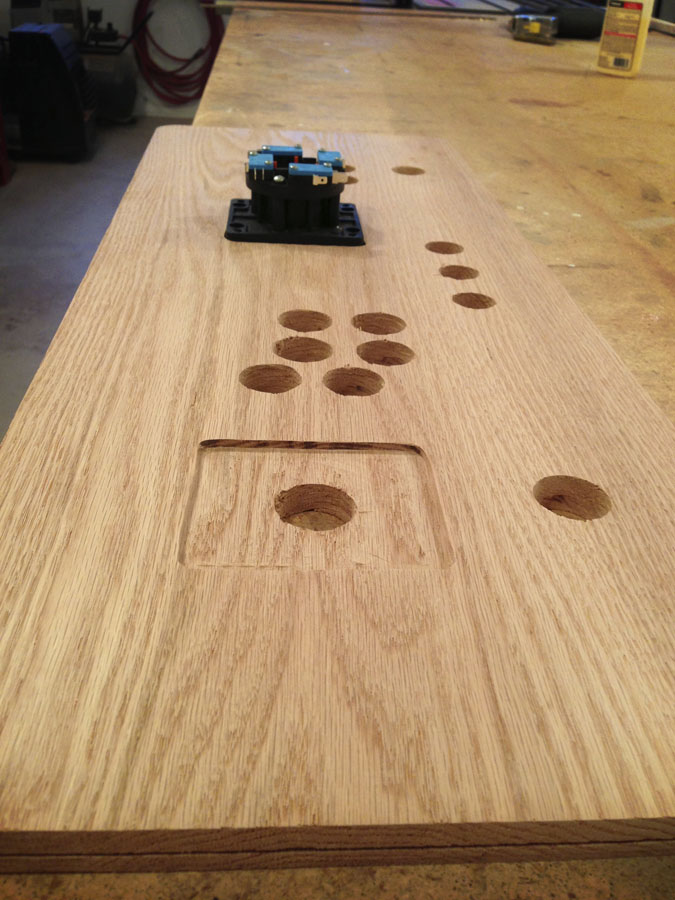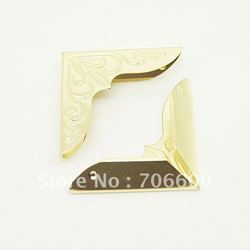So I decided to start a new project. Some of you may remember the previous bartop I did here:
http://forum.arcadecontrols.com/index.php/topic,128852.msg1316776.html#msg1316776With this new one I wanted to follow this criteria: a.) looks nicer if it is to be displayed and b.) can be put away if need be, but c.) is still easy to quickly hook up and play.
All of those things rolled together made me think of doing a "supergun" style controller, but shoving a small MAME PC inside it. The top control panel will have 2 players worth of controls with a 6 button layout, P1/P2 start buttons, and power/insert coin/exit buttons.
Guts inside will essentially just be the PC and an iPac. Motherboard supports audio and video out via HDMI, so the only external ports will be a PC-cord style power plug which will take any standard PC cord, and a female HDMI port that will take any HDMI cable. I bought these items from PartsExpress to accomplish that goal:
http://www.parts-express.com/pe/showdetl.cfm?partnumber=093-118http://www.parts-express.com/pe/showdetl.cfm?partnumber=181-784 - To connect the PC to the HDMI jack
http://www.parts-express.com/pe/showdetl.cfm?partnumber=090-442All of that should make the outside of the cab look fairly finished. The board I got generates hardly any heat at all, so I'm not sure if I'm going to need an exhaust fan yet or not.
I want this one to be really nice. No MDF and black paint like the bartop arcade game. I've got ideas for some little details along the way that I think will accomplish that.

The first of which - it's going to be made out of solid red oak. Red oak is kinda expensive, but it's worth it IMO, and looks gorgeous.
Enough explanation - on to what's done so far on the build:
Some measuring and pre-planning. We were going to 45 the edges to give them a more finished look, but I like the look of a stained edge of a piece of wood. The front and back panels will be flat, and the sides will have edges visible.


Test fitting overlap of the top. This was actually reduced slightly since I screwed up a couple things on this top and decided to start over with a new top, which is slightly smaller.


This is the base all put together. Notice everything isn't 100% perfect (look at the joints). This will be taken care of with hours of sanding.


This is the piece after a lot of sanding. One side was chopped down slightly and drilled for the piano hinge. The reduction in height will make the top sit flush on top of the box.

I re-created this SFA3 art in Illustrator and took it to a place and had it printed on adhesive 3M vinyl. I cut the characters out with a razor blade by hand and they'll be going on top of the control panel (obviously under plexi). I didn't want a solid CP top because I wanted the wood to be visible. Oak is pretty. No need to cover it all up.

On the final CP, Ryu will be on the P1 side and Ken will be on the P2 side. I cut the buttons in such a way that they won't have any holes in their faces.

I'm really hoping this will look great.

We sandwiched the characters between two pieces of plexi and put some heavy stuff on them to flatten them out. Couple days while we're staining and clear coating should do the trick.
On to the creation of the CP. I rounded the corners and slot-cut this piece. Notice the slot cut is not in the middle. After slot cutting the piece we ran it through a planer and took off about 1/16th of an inch from the top of the piece. This is so the clear acrylic, once placed on top, will sit perfectly flush with the top of the T-moulding. Details details.


You can see here the button layout I'm going with. Traditional Japanese style, but with only 6 buttons. I'm not using the right-most two buttons from the pic. I really like this joystick spacing and wish I would have used it on my bartop. I might re-do the CP on the bartop with this layout.
After drilling all those holes, I clamped my acrylic on top and got to work with a router and a flush trim bit.

The result is a perfect fit all the way around. Note the jaggies on the acrylic - that's the protective plastic that they put on the top and bottom so it doesn't get scratched - it's not rough. The actual cut is like factory. I love that flush trim bit!

Next I got to work with the Dremel drilling out all of the button holes. This takes a while, but using a standard drill bit in a Dremel tool really works well here. The holes end up perfect.

Many holes.



Button test fit. Poyfict.

Now it's time to fit the joysticks. I like to recess these - not a lot, but just enough to add stability. I went about 1/8" deep here. Could have gone deeper, but I wanted to keep as much real board there as possible just in case fighting game combat gets vigorous.


Notice there that the top 3 buttons holes are smaller than the rest (11/16" vs 1 1/8"). Those 3 buttons are going to be Ultralux lit buttons. I have a red one, green one, and yellow one for "Exit," insert coin, and power respectively. I made custom labels and put them inside the buttons. I'll get pics of those later. I was going to use lit buttons for the whole CP, but they're a bit stiff and I really like the feel of standard buttons. I read about the spring removal trick after the fact, so I might play around with the buttons and see if I can make them feel more like the Happ buttons and might toy with the idea of replacing them.
Now, time to stain. I used a pretty light colored stain that really brings out the grain of the wood. Pictures don't do this justice at all, and the lack of lighting doesn't really help either. The pieces came out really nice.



That's how I left it. Stain had to dry overnight. Tonight I can go back and put on the varnish, which will take a while to dry as well. After that's done the only thing I'll be waiting on are my electronics from Parts Express. I'll be leery drilling holes in this for those pieces after the stain and varnish are already on, but I wanted to get that part done ASAP because I hate waiting for dry time.
I picked up some nice, big screw-on plastic/felt feet for the bottom so it can be placed on a hardwood floor or coffee table and won't damage the surface. I also picked up some gold hardware like corner finishers similar to this for the bottom 4 corners:

The piano hinge is also gold, and I picked up a couple gold clasps to keep the lid closed (though I don't know if I'm going to use them or not - I need to see what they'll look like) as well as some decorative gold handles for the sides so the unit can be carried easily by 1 person without picking it up by the top, which might be bad.

I've never seen one of these done before, although I wouldn't be at all surprised if someone's already done it. If anyone has links to any projects that others have done that are similar I'd like to see them if you can provide links.
I'll keep updates coming as I get more done. Let me know if you guys have any ideas.
I hope picture quality is acceptable - I took them with my phone.




 Home
Home Help
Help Search
Search Login
Login Register
Register
 Send this topic
Send this topic Print
Print



